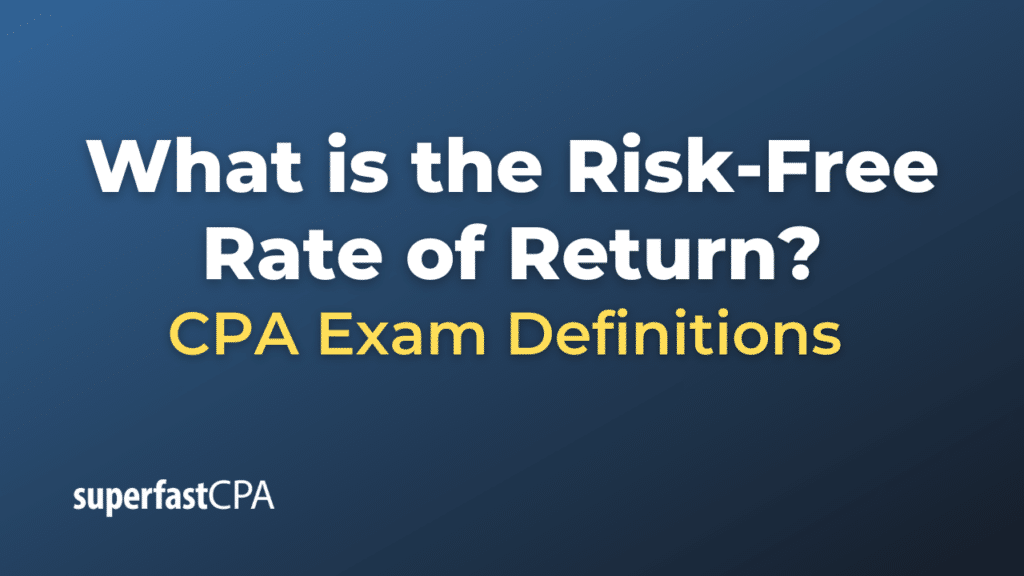Risk-Free Rate of Return
The risk-free rate of return refers to the theoretical rate of return on an investment that carries no risk. It represents the interest an investor would expect from an absolutely risk-free investment over a specified period of time. In practice, while no investment is truly “risk-free,” certain highly liquid and creditworthy instruments, particularly those backed by governments, are considered to approximate this ideal.
Key points about the risk-free rate:
- Benchmark: The risk-free rate serves as a benchmark against which the returns on riskier assets, like stocks or corporate bonds, can be compared. It provides a starting point for estimating the expected return of these assets by adding a risk premium.
- Determination: In many contexts, especially in developed markets, the yield on a short-term government Treasury bill (like the U.S. 3-month T-bill) is used as a proxy for the risk-free rate. For longer-term analyses, yields on longer-term government bonds (like the U.S. 10-year Treasury bond) might be used.
- Factors Influencing the Rate: The risk-free rate can be influenced by factors such as central bank policy rates, inflation expectations, and overall economic conditions. In general, if inflation is expected to be high, the nominal risk-free rate would also be high, but the real (inflation-adjusted) risk-free rate might remain low.
- Use in Models: The risk-free rate is a crucial component in various financial models. For instance:
- Capital Asset Pricing Model (CAPM): Used to determine the expected return on an asset, considering its risk relative to the overall market.
Expected Return = Risk-Free Rate+ β(Market Return − Risk-Free Rate) - Discounted Cash Flow (DCF): Used to discount future cash flows back to their present value when valuing an investment or project.
- Capital Asset Pricing Model (CAPM): Used to determine the expected return on an asset, considering its risk relative to the overall market.
- Real vs. Nominal: The risk-free rate can be either real or nominal. The real risk-free rate is adjusted for inflation, while the nominal risk-free rate isn’t. In contexts where inflation’s impact is essential, like long-term project valuations, the real rate might be more relevant.
- Global Variance: The risk-free rate isn’t the same across countries. Different countries have various economic conditions, creditworthiness, and inflation rates, leading to different risk-free rates. This discrepancy can sometimes lead to “carry trades” where investors borrow in a currency with a low-interest rate and invest in a currency with a higher interest rate.
It’s worth noting that while government bonds are typically used as proxies for the risk-free rate, they aren’t entirely devoid of risks. They can be subject to interest rate risk, and in the case of governments with lower creditworthiness, there might even be a default risk. However, for practical purposes and in the context of more volatile markets, they’re usually deemed “risk-free.”
Example of the Risk-Free Rate of Return
Let’s use the risk-free rate in the context of the Capital Asset Pricing Model (CAPM) to estimate the expected return on a stock.
Scenario: Imagine you’re an investor considering buying shares in Company XYZ. You want to estimate the expected return on this stock to determine if it offers a sufficient return for its level of risk.
Given:
- The risk-free rate, which is the yield on a 3-month U.S. Treasury bill, is 1%.
- The expected market return, which represents the average return for the entire stock market, is 8%.
- Company XYZ has a beta (β) of 1.5. Beta measures the stock’s volatility compared to the overall market. A beta greater than 1 indicates that the stock is more volatile than the market, and vice versa.
Using CAPM, the formula to determine the expected return on the stock is:
Expected Return = Risk-Free Rate + β( Market Return − Risk-Free Rate)
Calculation: Plugging in the given values:
Expected Return = 1% + 1.5 (8% − 1%)
Expected Return = 1% + 1.5 × 7%
Expected Return = 1% + 10.5%
Expected Return = 11.5%
So, given its risk level (as measured by its beta), you would expect a return of 11.5% from investing in Company XYZ’s stock. This return compensates you for the time value of money (using the risk-free rate as a baseline) and the additional risk associated with the stock’s volatility relative to the overall market.
You would then compare this expected return to your personal required rate of return or other investment opportunities to decide whether to invest in Company XYZ’s stock. If your personal required rate of return was, say, 10%, then Company XYZ would be a viable investment option since its expected return of 11.5% exceeds your threshold.













